

Your Guide to Starting a Piggery Business in the Philippines (2021)

Piggery business is one of the traditional businesses of Filipinos. The industry ranges from backyard ventures to commercial scale. This business has thrived because of one thing: Filipinos love to eat pork.
Here, we will guide you on how to start your piggery business.
The Piggery Business in the Philippines
Despite the current pandemic, the demand for pork is still high. According to Statista, in their June 2021 report , Filipinos consumed about 14.9 kilograms per capita. It also mentioned that it is expected to rise this year. This simply means that the piggery business will continue to thrive.
According to the Philippine Council for Agriculture, Aquatic and Natural Resources Research and Development (PCAARRD), the swine industry is a P191-billion industry . Among the agricultural products, it is second to rice production. However, more than half of the swine industry (65%) depends on backyard production.
Pros and Cons of Piggery Business
The piggery business is profitable. That it has thrived for decades is strong proof of its viability. Among its notable advantages are the following:
Fast Growth Rate = Fast ROI
One of the advantages of the piggery business is its fast return on investment. Quick turnover is due to the short interval between raising and harvesting. One can expect to sell a pig after raising it for five months.
They have good feed-to-meat conversion. This means that the amount and quality of feeds you give them will be converted to more weight and tasty meat.
High demand
As mentioned already, Filipinos love to eat pork so much that we have to import pork from other countries. Due to African swine flu in other countries, the importation of pork has been banned. This increases the demand and price.
Easy to Raise
They don’t need much space and they are docile animals. Moreover, they are easy to breed.
Cheap to Feed
Pigs are not picky eaters. You can supplement commercial feeds with other feeds like kitchen and agricultural wastes. These can bring the cost of feeding down.
Not prone to diseases
Compared to other livestock, pigs are relatively hardy. They don’t easily get sick like chickens, for example. Aside from this, they can also easily adapt to different environments. This means the risk of losing your investment due to diseases is brought low.
Smelly business
Pigs are friendly animals, but they have an unfriendly smell. Pigs produce offensive odor coming from their manure, urine, and wastewater. There are environmental laws and local ordinances that state where and how pigs should be raised.
Noisy business
This is not as bad as the smell, but pigs can be noisy. Pigs make high-pitched squeals when they are hungry, fighting, or threatened. Sometimes the squealing can be a nuisance. Like the smell, laws and local ordinances have to be followed when one puts up a piggery.
Commercial feeds prices
Commercial feeds offer convenient feed management and preparation. Commercial feeds provide a well-balanced formulation of nutrients, thus helping in the optimal growth of pigs. The problem is that these feeds are expensive. There is a low-cost alternative which is to feed the pigs with kitchen and agricultural wastes. But this is only viable when these feeds are readily available and with enough and steady supply. If these are not so, then you have no other choice but to rely on commercial meals. Experienced piggery businessmen say that 70-80% of the total cost of the whole operation .
Yes, pigs are hardy animals, but they can get sick too. Asian swine flu can wipe out your mob. If not controlled, it can put your investment in trouble. Gastrointestinal diseases are not as bad as the African swine flu, but they should be attended to. You have to spend on veterinarian’s services and medicines.
Inclement Weather
The biggest challenge concerning the weather is typhoons. Typhoons can damage the shelter, and several things could happen to the pigs. They could be crushed and killed or injured by the falling structure or flying debris. If not killed, they could escape the shelter.
Business Risks of a Piggery Business
The different items mentioned as cons above are already considered as risk factors. Before jumping into the piggery business, you have to consider the risks. There are environmental, health, and financial risks involved. This is where a good business plan comes in.
The Importance of a Piggery Business Plan
In any business, the risk is always present. You cannot eliminate it, but you can minimize it by having a piggery business plan.
However, a good business plan’s primary function is not to address risks but rather to provide a roadmap towards success in entering the business. Through it, the goals and expectations will be achieved.
Piggery Business Plan Sample Outline
This is just to give you an idea of what is expected of a piggery business plan. If you want to know more about creating a business plan, go to this blog found in Franchise Market Philippines, Ultimate Guide in Creating a Business Plan in 2020 .
Executive Summary
This section gives the piggery business stakeholders a picture of the overall content of the business plan. This would include the following: an overview of the business, the goals, objectives, mission, vision, projects, teams, and other departments.
Include also the individuals you are still to hire. Discuss how they make a good fit for your company. Mention how the company will be managed.
Financial Plan
This is a very important part. Here, you discuss financial forecasts and source funding for capital.
The appendix should have references, diagrams, tables, and others that support the business plan.
Type of Piggery Business
One of the things that you have to decide on before you start is the type of piggery business you want to have.
Breed and Grow vs. Grow-Out
With regards to piggery business operation, you decide whether it will be breeding and fattening or grow-out.
When reproducing and growing, you purchase a few quality piglets to grow to become your breeders. You can raise them to become a boar and a sow or several sows. Or you can have sows only and have them artificially inseminated or have mated with boar from other piggeries.
The piglets produced will be grown for marketing. This model takes time, but you have breeders, so there is no need to buy piglets for an increase.
The other one is the grow-out model. Some call this the “fattening model.” You buy piglets and grow them. When they reach marketable age and weigh at least three-month-old, you sell them. This model gives the business a fast return on investment. The downside is that you keep buying piglets from others.
Independent Grower vs. Contract-Grower
As an independent grower, you shoulder everything in the business from acquiring the permits, building the facilities, raising the pigs until the selling. The advantage of this is that you have control over the company. The disadvantage is that the whole load of work is on you.
The second type is contract growing. Here, the grower (piggery owner) partners with big companies to process and market hog products. The piggery owner provides pig buildings, electricity and water supply, workforce, security, and permits.
On the other hand, the company offers the piggery owner hybrid pigs, quality feeds, medicines, veterinary services, delivery and hauling services, processing and marketing of the hogs, and reasonable payment.
This set-up is advantageous to piggery owners with not enough capitalization for the business. Another thing is the technical know-how that you get from this successful company. The disadvantage is that you are pressured to produce. Partly, you are not in control of the business.
On the other hand, the company gets a reliable, steady source of hogs without worrying about growth. It also frees them from legal obligations concerning labor and permits. Monterey Foods, Pilmico, CP Foods, and Excel Feeds are companies that are into hog contract growing.
Facilities and Equipment Needed
Pig shelter and pens.
You need to provide the pigs with a pig shelter to protect them from the elements of nature. Its location should be away from houses due to the offensive odor that pigs produce. The most common shelters in the Philippines are made of concrete and metal sheet roofing.
Inside the house should be a pen or pens for easy pig management. When building a pen, you have to consider that each pig needs four square meters of space.
For example, you have four pigs. This means that you need to build a pen the size of 16 square meters for these pigs. The most common cells here in the Philippines are made of concrete. But you can also use metal gates. One advantage of metal gates over concrete is that you can change the configuration of the pens.
The floor of the shelter and the pens should be made of concrete because it is more efficient when cleaning.
The size of the pig house and the number of pens depends on the number of pigs you want to raise.
Feeders and Water Troughs
Feeders and water troughs are needed to hold feeds and water for the pigs. The best feeders and troughs are made of concrete. They are heavy and sturdy. However, other materials may be used like discarded automobile or truck tires cut into half as feeders and troughs.
These are the necessities. As you grow in your business, you can add some automatic feeders and waterers later.
Business Requirements for a Piggery Business
To avoid legal inconveniencies later, your piggery should comply with the different legal requirements for starting a business here in the Philippines.
The requirements given here will just be a summary. You can check out this blog, Legal Requirements for Business in the Philippines , for the complete list of requirements needed to start a business or you can inquire through the concerned agencies directly.
Register Your Piggery Business
There are three types of business ownership: sole proprietorship, partnership, and corporation. For sole proprietorship, register with the Department of Trade and Industry (DTI) office. You may check the procedure and requirements in registering on DTI's website .
For partnerships and corporations, register with the Securities and Exchange Commission (SEC). For collaborations and corporations, you may access the SEC’s website .
Secure a Mayor’s Business Permit
Go to the local government unit where you want your piggery business to be. Go to their city or municipal hall to secure the Mayor’s permit. Be aware that this permit has many requirements that you have to work on beforehand. Here are the following:
- DTI Business Name Certificate for a sole proprietorship
- SEC Articles of Partnership, or SEC Certificate of Incorporation
- Barangay Clearance/ Permit
- Authorization letter of the owner with ID
- Contract of Lease or Land Title / Tax Declaration
- Sketch of Location
- Occupancy Permit
- Location Clearance
- Public Liability Insurance
- Community Tax Certificate (Cedula)
- Fire Permit
- Sanitary Permit
There are other additional documents or permits that the city or municipality may require from you.
Register with the Bureau of Internal Revenue (BIR)
Your business must be registered with the BIR to be given the Tax Identification Number (TIN). Visit the BIR’s Revenue District Office (RDO) of the place of your proposed piggery business. Go to BIR’s TIN Application Information page to have an idea of the requirements.
Register with the SSS, PhilHealth and Pag-Ibig Fund
If you are hiring workers, they need to be registered with these three government agencies for their workers’ benefits.
Social Security System is in charge of retirement and some health benefits. Philippine Health Insurance Corporation (PhilHealth) provides health benefits solely. Lastly, Home Development Mutual Fund (PAG-IBIG Fund) is for housing loans.
Each agency requires the employer and employees to share in the monthly contributions for the workers’ benefits.
Secure an Environmental Certificate
The blog, Legal Requirements for Business in the Philippines, does not discuss this. An environmental certificate is one of the requirements for a Mayor’s Permit.
Depending on the number of heads you will raise, you will be required to acquire either a Certificate of Non-Coverage (CNC) or an Environmental Compliance Certificate (ECC) by the Department of Environment and Natural Resources (DENR).
A piggery business with less than 100 heads will be required to apply for a CNC. If a piggery has more than 100 heads, an ECC is required. A CNC or an ECC can be obtained from the DENR’s Environmental Management Bureau Regional Office of the region where the proposed piggery will be located. To know how to apply for a CNC or an ECC, go to DENR’s Environmental Compliance Assistance Center page .
Location Requirements of a Piggery Business
As you choose the site for your piggery, be aware of the national laws and local ordinances affecting the location of your pigpen, like the zoning laws, distance from the nearest buildings (residential, commercial, and others), and the distance from the source of ground and drinking water, etc.
The Resolution 674 series 2000 of the Housing and Land Use Regulatory Board (HLURB) will give you the rules and regulations regarding piggery location.
This document even gives the features of the ideal site. Some key features mentioned are the following:
- It shall preferably have a rolling terrain to provide better drainage. It is not flood-prone.
- It shall not be built on high moisture soil since this tends to hold water.
- It shall not be located in urban areas.
- It shall be no less than 25 meters away from the nearest source of ground and drinking water.
Choosing the Right Piglets
To have a profitable piggery business, one of the most important requirements is to have the right piglets. The Agricultural Training Institute of the Cordillera Administrative gives the different considerations when purchasing piglets.
- Buy weaners, piglets that had been weaned from their mother for at least 1-2 weeks.
- If possible, buy piglets from one source or farm to come from the same breed.
- Buy piglets that are of high quality and healthy. You can ask the help of an experienced piggery farmer or a veterinarian.
- Avoid buying the piglets that are being peddled (you are not assured of their health and quality).
Feeding Management of the Pigs
To grow healthy and optimally, Pigs need to be fed with all the nutrients they need at different stages of their growth. For this to happen, their feeding should be managed or programmed. This is the advantage of commercial feeds over DIY, low-cost alternative meals.
Commercial feeds have a type of feed for each stage. They offer the following: booster, weaner, pre-starter, starter, grower, and finisher. To give an idea of feed programming with commercial feeds, here is a sample program from one hog feed manufacturer :
Feeding management is one of the conveniences of commercial feeds. Another is the preparation. Since they are dry, they are easy to prepare. But the downside is the cost. Commercial dinners are expensive and could cut immensely on your profit.
If you find them expensive, consider low-cost alternative feeds. Some alternative meals are rice bran, banana trunks, sweet potato (leaves, vines, roots), and many others. Remember that pigs are not picky eaters.
If you are interested in this, read Backyard Piggery Project . It gives you alternative feeds and even the formulation of mixing them to achieve the health and growth you want to see in your pigs.
Piggery Farming Tips
Tips that will be mentioned here are related to the capacity and the capability to do this business.
Start Small
If you have zero experience, try the traditional Filipino share growing. The Cebuanos call this “pabatnan.” This is backyard farming, but you partner with someone knowledgeable and have the place to raise pigs. You either buy a sow to breed or a piglet to grow. Your partner will be the one to care for and feed the sow until it produces or the piglet until it is marketable.
In the case of breeding, you sell the piglets and divide the profit or divide the number of piglets between the two of you. There should be an agreement at the beginning of how you will divide the outcome.
In the case of growing out, your partner will fatten the piglet until it is marketable. You sell the piglet and divide the income.
This system provides a good experience in the piggery business. It gives a picture of the whole process so that when you launch out on your own, you will have some idea of what to do.
Even when you will venture on your own, to start small is wise. Start with a few piglets. Get the experience before expanding.
Get Financial Aid
Get some help if you do not have enough funds to start your business. Franchise Market Philippines has this blog to assist you in getting funds if you do not have enough capital. Read 9 Best Ways to Find Funds for Your Business .
Get Technical Help
To succeed, you need to have enough technical knowledge about the business. There are a lot of institutions offering training or seminars on the piggery business.
Check these institutions and organizations that provide piggery business training or seminars.
- The Agricultural Training Institute of the Department of Agriculture
- International Training Center on Pig Husbandry , ATI, Department of Agriculture
- Search for Raising Organic Hogs
- Search for Animal Production (Swine)
- Hog feeds manufacturers
Piggery business is a profitable business, but you have to understand the business just like any business.
Understand the advantages and the disadvantages. Be aware of the risks. To navigate success in the piggery farm armed with the knowledge of its opportunities and threats, you have to write down a business plan. Without the business plan, you could waste a lot of money and time.
Aside from the business plan, get to know the requirements and the operation of the business. All of these will help you to the destination that you want to reach.

Ultimate Guide to Franchising
Avoiding scams, making smart investments, and better decisions.
The franchise industry is booming, and entrepreneurs are wondering about how this sector works. This ebook aims to help aspiring franchisees achieve their business goals.
Disclaimer: Franchise Market Philippines strives to provide relevant and accurate information in all its articles. However, some information in our articles may differ or might be outdated from what you can see or read directly from the establishments' or businesses’ websites. Please get in touch with us directly for any discrepancies.

Recommended articles

7 Easy Steps to Boost Your Self-Confidence (and some extra…
Best digital marketing tools in 2023 to help grow your…, 10 practical ways to save money while shopping online, 15 best credit cards in the philippines 2023, 30 top searched franchises in the philippines in 2022, 30 best products to sell online in the philippines (2023), 10 top coffee shop franchises in the philippines, the top 15 richest filipinos (2022), top 15 corporations in the philippines to grow your career…, how to get a business loan in the philippines, 15 ways to achieve financial freedom, most iconic and other promising successful filipino…, 30 top searched franchises in the philippines in 2020, how to select a franchise location in the philippines, comprehensive guide to franchising in the philippines (2020), how to select a franchise in the philippines, why should you be franchising when you have other options, why you should franchise in the philippines now (2020), most read articles.

15 Business Trends in the Philippines (2023)
16 best milk tea franchises in the philippines (2023), your guide to starting a water refilling station in the…, great business ideas to pursue this 'new normal', 30 practical tips on saving money for filipinos in 2023, top 32 online and home based jobs in the philippines (2023), 20 passive income ideas in the philippines (2023), ultimate guide in creating a business plan in 2020, 18 best life insurance in the philippines (2023), 20 best investments before retirement in philippines (2021).

Other related articles

Why Your Business Absolutely Needs SEO
Unlock the potential of your business with essential SEO strategies. Discover how search engine optimization (SEO) can drive organic growth, enhance…

To the New You! 7 Secrets to Self-Improvement
Discover the path to personal growth and self-improvement with "To the New You! 7 Secrets to Self-Improvement." This transformative guide offers…
Whether we're going to a new job or interviewing for your dream internship, self-confidence is key to excelling in these situations. Learn how to…
Be informed with the latest Franchise
Ultimate Guide to Franchising Avoiding Scams, Making Smart Investments, and Better Decisions
Quiz: Are you suited to become a Franchisee?
- All Business
- Business Ideas
- Franchising
- Small Business
- All Entrepreneurship
- Freelancing
- Human Resource
- Productivity
- All Marketing
- Blogging / Content
- Inbound Marketing
- Social Media
- Money Management
- Saving Money
How to Start a Piggery Business in the Philippines
A piggery is one of the more traditional businesses you can find in predominantly agricultural areas in the provinces. Some families initially raise pigs in their backyard as a source of food. But eventually, they end up expanding the facility or venture to larger areas to start a full blown piggery business.
One of the reasons why a piggery is a viable business idea is because Filipinos love to eat meat and pork is our primary staple.
According to a study by United Kingdom research firm Chatham House, the Philippines ranks among the top 10 meat consumers in the world. The United States and the United Kingdom lead the world at 115kg and 80kg per person per year respectively.
On the other hand, the average Filipino eats 35kgs of meat per year. Of the 35kg, 15kg is from pork. In terms of livestock production , pork accounts for 60% of the industry with chicken coming in second at 27%.
Why do Filipinos prefer pork over other sources of meat?
- It’s affordable.
- It has a pleasant taste; comparable to chicken.
- Pork can be cooked and prepared in many ways.
Not many people know that pork can be healthy depending on the cut and how it is prepared. Unlike steak where the fat resides in the meat, with pork the fat is located outside. Cook the meat with the fat on to ensure juiciness then slice it off before eating.
Roasted pork loin, grilled Butterfly pork chops and ground pork as chili con carne can be prepared and served in a healthy manner. And they will not break the budget.
In fact, a growing segment of the piggery business is raising native pigs which are healthier because the cholesterol count of the meat is significantly lower than commercially grown pigs.
The livestock industry continues to grow by a modest 3.25% or 61 Billion Pesos. Of this figure, piggeries accounted for the highest contribution at 3.76%.
Table of Contents
Business Risks of a Piggery Business
1. Vulnerability to Diseases – Over the years, we’ve read stories of people getting sick or afflicted with certain conditions after eating pork. Many pigs were slaughtered to prevent further contamination of livestock. Pigs are vulnerable to diseases which could be a consequence of the following:
- Unsanitary farming conditions
- Contaminated feed
- Co-mingling with pigs from other sources during transportation
You will have to factor in contingencies in the budget that will prevent your pigs from getting infected and sick or reducing the risks of an outbreak.
2. Inclement Weather – In 2015, Typhoon Lando destroyed 517,000 Pesos worth of livestock in Ilocos, the Cagayan Valley, Central Luzon and the Cordillera regions.
It is very important that the pens are constructed from a sturdy concrete material. You should also install efficient drainage systems to keep water from overflowing.
3. High Cost of Feeds – Regular and systematic feeding schedules are important to ensure the size and quality of the pig. But an increase in the prices of feed can seriously impact your profit margins. As a matter of fact, in 2013 62,000 tons of pork was imported from the US and Canada because locally grown commercial pigs became too expensive.
These risks are very real in the Philippines which is a net importer and has unpredictable weather.
As contingencies, make sure you have a veterinarian on duty at your piggery. It may add to your monthly budget but consider the veterinarian as insurance versus diseases.
To manage your costs on feeds, you can try to source cassava, camote, corn and corn by- products that have been discarded from nearby farms or slaughterhouses as options. But make sure these items are properly cleaned and thoroughly cooked before feeding to the pigs.
Determining Your Business Set Up
There are two ways you can go about in setting up the piggery.
First is by acquiring starter pigs or adopting a grow- out system. In this setup, you acquire the pigs when they are young; around 12 to 20 kg in weight. Through a consistent feeding cycle, you grew the pigs until they reach 90kg before selling them.
A young starter pig can cost around 1,600 to 2,000 Pesos. It will take approximately three months of feedings before the pig can be sold.
The second approach is by breeding the pigs. You will have to acquire the sow which usually costs around 12,000 Pesos. It will take the sow 4 to 6 months to give birth.
Between the two approaches, acquiring the starter pigs is more popular because the time period from feeding to market is much shorter. With pig breeding, it will take you almost a year before you can start selling the pigs.
Another advantage of the grow out system over pig breeding is that you incur fewer expenses in hiring specialized labor in managing the sow and the newborn piglets. The risks due to business losses are also less with the grow out system compared to pig breeding because there are fewer investments in infrastructure and equipment.
The key to succeeding in a grow out system is timing the sale of the pigs. Farm gate prices usually rise during the months of November to February. With this in mind, you should buy the starter pigs beginning August.
Business Requirements for a Piggery
If you are interested in setting up a piggery, here are the requirements you need to submit to legalize your operations:
- Business Name Registration – You will have to register your business name with the Department of Trade and Industry provincial office where your proposed piggery is located. Your business name will be valid for up to 5 years.
- Barangay Clearance – Visit the barangay office where you plan to set up the piggery business.
- Mayor’s Permit and License and Sanitary Permit – You can secure this from the local government. Your license and permit have to be renewed every year.
- Tax Identification Number (TIN) – Visit the office of the local Bureau of Internal Revenue (BIR) office in the province.
- Environmental Compliance Certificate – A piggery carries potential risks to the environment. There will be guidelines that you will have to comply with strictly. You can get the ECC from the Department of Environment and Natural Resources (DENR) which is located at Visayas Avenue, Diliman, Quezon City.
Related: 5 Essential Business Permits and Licenses in the Philippines
Location requirements of a piggery business.
Back in 1995 as I was driving along EDSA at around 9:00 pm, I noticed there was a horrible stench permeating the interior of my car. I had the windows up, but the smell was nauseating.
I noticed in front of me was a six wheeler that was pouring liquid on EDSA. People were honking their cars and cursing at the people who continued to pour the liquid without hesitation.
By the time I got home at 11 pm, the smell had become overbearing. Everyone in the house could smell it even with the doors and windows closed.
The following morning, the sun revealed the car’s underside was covered with discarded pig parts and fluids which the car cleaning company said were composed of urine, feces, and blood. According to the cleaners, mine was not the first car they serviced that morning.
The 6 pm news revealed that police arrested the owners of a piggery that dumped the nasty fluids along EDSA the night before. Apparently, the truck was stopped by the police along Commonwealth Avenue in Quezon City.
A piggery is a good business, but it carries environmental risks. Waste disposal is of paramount importance and the ensuring the cleanliness of the pens will protect the pigs from getting sick or infected with communicable diseases.
When it comes to a piggery business, location is not enough. It must be situated in an area which complies with environmental guidelines:
- The piggery must be located outside the proximity of urban areas.
- The piggery must be located at least within a 25-meter radius from sources of ground or surface drinking water.
- Medium and large scale piggeries must be located at least 1,000 meters away from residential, industrial, institutional and commercial areas.
- 86m – 2.79m per sow
- 74m – 1.12m per head of pig under 100 pounds
- 12m – 1.86m per head of fattening pig from 100 to 200 pounds
- 32m – 3.25m per boar
It would be a plus factor if the location has a slight slope or incline to minimize the risks of flooding.
Constructing Housing for the Pigs
My dad’s driver, Greg, got into the piggery business in early 2000. In addition to being a good driver, Greg was a wonderful guy. I was working in my dad’s ship- staffing agency back then and every Christmas, Greg would contribute a roasted pig or lechon during the staff party.
I think it was in 2006 that Greg lost his piggery when a strong typhoon ripped through his province, destroyed the pens and drowned all the pigs. Although Greg recovered his investment, it was such a horrible experience that he never went back to the business again.
Construction of housing for the pigs is very important. You have to make sure the pens are stable, sturdy and regularly sanitized. It is strongly suggested that you use concrete flooring for easy cleaning. Pigs are highly susceptible to diseases and parasites.
You should have an area in the pen that you can use to isolate pigs that have been infected with contagious bacteria. With regards to contamination, only buy pigs that have been immunized for hog cholera and swine plague.
If you decide to go with concrete, make sure these are not too rough, or it may lead to foot injuries and expose the pigs to bacterial contamination. The concrete must not be too smooth that the pigs are constantly slipping and sliding.
If your area is prone to typhoons, you should be prepared to invest in a strong shelter for the pigs. There must be adequate drainage, and the pens should be located in a slightly sloping area to reduce the risk of flooding.
For small scale operations, pens made of bamboo or nipa may be used, but you should implement a regular cleaning schedule.
The pig houses must be fitted with feeders and drinking troughs. Although some piggery owners use old, used automobile tires, it is better to make them out of concrete.
Feeding the Pigs
You have 3 to 4 months to get the piglets to grow to marketable size. It is very important to use a high-quality feed to ensure the health and safety of the meat and by-products.
Here is a typical feeding schedule for a grow out piggery system:
- Start feeding the piglets with high-quality pre- starter ration at one week of age. The ration changes at different growth stages but it should be done at a gradual pace to allow for a natural transition in the feeding behavior of the pigs. Usually, a one- week transition would suffice.
- A starter ration is given when the pigs are at two months of age and weight comes in between 10 and 25kg.
- The grower ration is for pigs that are at 30 to 35kg and until they reach 15 to 20 weeks old.
- A finisher ration is given when the pigs reach 60kg or around 20 weeks old.
- A ration should always include sufficient amounts of carbohydrates, protein, vitamins and minerals.
- Always provide the pigs with clean drinking water.
There are some commercial operators of piggeries that use dry feeding to streamline labor and feeding equipment costs. Backyard operators prefer wet feeding.
Environmental Factors and Issues with the Piggery Business
Before starting a piggery, you should understand the business carries serious implications on the environment.
Gas emissions and waste products could compromise surface and ground water quality and safety. It is also an enterprise which elicits unpleasant odors which could be bothersome to nearby residential areas.
You should have sound manure management policies and practices in place to ensure proper disposal of waste and control of gas emissions. Among the gasses produced by a piggery business include ammonia, carbon dioxide, methane, and nitrous oxide.
Carbon dioxide, methane, and nitrous oxide have been identified as contributors to global warming.
Some studies contend the increasing scale of livestock enterprises the last few years have accelerated adverse environmental conditions. To address the situation, technology has been developing ways to convert waste products into useful products such as biogas fertilizers.
For now, however, you should ensure top level management of waste disposal procedures and institute measures to contain gas and foul odor emissions.
Managing a pig pen will require you to routinely go through a checklist of things that need to get done. If you cannot be there full- time, hire someone you can trust to manage the piggery. But you should make your presence felt at the piggery as often as you can.
Recommended Read: Top 15 Small Business Tips in the Philippines for 2017
Another concern for piggery business owners is the incidence of theft. Conduct an inventory of your pigs, feed, and other supplies and emphasize accountability to everyone who works in the piggery.
But if you can get the right location to support operations and take all the necessary precautions to ensure the health of the pigs, a piggery business could be a long- term, financially- rewarding enterprise for you.
Ricky Sare is a writer, an entrepreneur, and a member of Tycoon Philippines editorial team. He is also the owner of Benchmark Global Management Solutions, Inc. , a BPO company located at Makati.
You may also like

How to Implement Predictive Analytics in Your Business
Predictive analytics is a powerful tool that leverages data, statistical…

9 Budgeting Lessons for Someone Who’s Not Naturally Good with Numbers
For the most part, most of us can grasp the importance of budgeting.…

Improving Customer Service in a Hardware and Construction Supply Business
In the increasingly competitive business-to-customer (B2C) and…

The Evolution of Social Media Platforms: A Comprehensive Analysis
Social media has become a significant aspect of modern life, connecting…

8 Mistakes in Web Design That Your Business Should Avoid
While it’s essential for businesses to build a website, it shouldn’t be done…

Short Selling Stocks: Should You Do It?
Short selling is kind of like placing bets on sports. Bettors are similar to…
- Agriculture Farming
- Livestock Farming
Project Reports
- Hydroponics
- Best Fertilizers
- Vertical Farming
- Sheep Farming
- Goat Farming
- Poultry Farming
- Fish Farming
- Pig Farming
- Dairy Farming
- Rabbit Farming
- Success Stories of Farmers
- Boost Fruit Yield
- District Wise Crop Production
- Schemes & Subsidies
- Agriculture Colleges
- Farm Insurance
- Disease Control And Management
Agriculture
Aquaculture
Horticulture
Agri Business
Pig Farming In The Philippines, How To Start
Table of contents, advantages of pig farming in the philippines, different pig breeds in the philippines, location requirements and recommended layout for piggeries, construction of pig houses in the philippines, know the risks in pig farming, provide comfortable housing and feeding schedule, different ways to start pig farming in the philippines, feeding management for pig farming in the philippines, health management for pig farming, overall tips for pig farming in the philippines, cost to start piggery business in the philippines, requirements for pig farming in the philippines, problems for pig farming business in the philippines, business risks of a piggery business, frequently asked questions about pig farming in the philippines.
Introduction to pig farming in the Philippines : Pig farming is defined as the raising and rearing of domestic pigs as livestock, and a branch of animal husbandry. Pigs are mainly raised for food (such as pork, bacon, gammon) and skins. Pig farming is also called hog farming or swine farming. The Philippines is located in Southeast Asia. Pig farming in the Philippines has been a lucrative business for Filipinos for decades. Its popularity is seen in the backyards of rural families. The world’s 10th largest consumer, 8th largest producer, and 7th largest importer of pork are the Philippines. In this article we also covered the below topics about pig farming in the Philippines;
- How to start a pig rearing business.
- What are the common breeds of pigs in the Philippines
- Is pig farming profitable
- How do you start a pig farm business
- Pig farming requirements
- Determining the business set up for pig farming in the Philippines
- How to start a pig rearing business
- Commercial piggeries in the Philippines
A step by step guide on how to start pig farming in the Philippines , pig breeds, cost to start pig farm in the Philippines

Pig is a more traditional business that you can find in the provinces, mainly in agricultural areas. Some families initially make a source of pork in their backyard. But eventually, they expand the facility or do business in larger areas to start a pig farming business. The pig sector is the 2nd largest economic activity in the Philippine agricultural sector. Domestic pig production is growing in both backyards and modern commercial farms.
Pig rearing is a well-known company in the Philippines because of the proliferation of backyard producers that dominate the swine industry and healthy commercial sector. Most of the business in the agricultural parts of the provinces involves raising pigs. Although some families use it for food, most ventures move on by setting up facilities to run a large-scale pig business. It is important to know what you need to do to succeed in this line of work. That’s why this article will provide the information you need to know about start pig farming in the Philippines.
- Usually, Pigs convert foodstuffs, feeds, certain grain products, meat from mills, through products, spoiled feeds, and waste into valuable nutritious meat. Most of these feeds are either inedible or not very popular with humans.
- The pig grows fast. It is capable of producing 2 liters per year under the best management conditions.
- The carcass return is very high, i.e., 60-80% of the living body weight.
- With a small investment in building and equipment, proper feeding, and disease control programs, the farmer can use his time and effort in this lucrative business.
- Pig excrement is used as fertilizer to maintain soil fertility. However, feeding damaged grains, garbage, and other unbalanced rations can reduce feed efficiency.
- They are prolific with short breeds. A sow can be produced at 8-9 months of age and sown twice a year.
- Pigs are known for their meat production, which ranges from 65 to 80 in comparison to other breeds of cattle, whose dressing yields cannot exceed 65%.
- Pork is rich in nutrients with more fat and less water and has a better energy value than other meats. It is rich in vitamins such as thymine, niacin, and riboflavin.
- Pig manure is widely used as fertilizer for agricultural farms and fish ponds.
- The rate of capital turn-over rate is fast in pig farming compared to farrow-finish operations.
- Special labor and necessary arrangements required for the rearing of herds and newborn pigs are avoided.
- The cost for halting operations is relatively small with grow-out operations. The loss associated with closure is the cost of useless buildings and equipment.
There are many imported breeds in the country and it is difficult to find the best breed. Here’s a guide to help you breed based on your goals, money, and experience.
Different breeds to choose;
Currently, there are several breeds of pigs that can be bred in the country. These are Landrace, Large White, Patrine, Dorothy, Hampshire, and Filipino.
Yorkshire or large white – Yorkshire is completely white with medium, erect ears. Sows have a high maternal capacity, wean the field and milk, and are excellent milk producers. It fits well in captivity but not in harsh conditions. Slaughterhouses receive a high percentage of dressing, produce excellent quality meat, and compare favorably with other breeds for growth and economy.
Landrace – Landrace is white, with short legs and medium to large inclined ears. The sows are known for their excellent performance in the mother’s ability and the size of the dirt. They are heavy dairy farmers and produce pigs with better growth rates and efficiency in feed consumption. When crossed with other breeds, they produce highly acceptable carcass pigs. However, they are weak on their feet and legs and have difficulty adapting to harsh conditions. Such defects must be corrected through proper selection and breeding. Landrace breeds are white or pink and have small ears. It is tall but thinner than other breeds. It is known for its mother’s ability to change its diet well into its weight.
Duroc – The color of Duroc comes in a variety of shades of red. The Sows are fruitful and are good mothers. They breed pigs that have better growth rates, better feed conversions, and better performance in harsh conditions than any white breed. These pigs are reddish-brown and golden yellow, with large frames, medium length, and muscular. They are the least aggressive of all meat-bred swine breeds. Although Duroc pigs are known for their deep red color, their colors range from light golden shades to deep reddish-brown. It is a very popular breed of meat, and its cultivation is very profitable for farmers. The breed has also recently served as foundation stock for some mixed-breed commercial pigs.
Hampshire – Hampshire is black with a white stripe around the shoulder and body. They are usually short-legged and lack body thickness. The sows have a reputation of weaning a high percentage of the pigs farrowed and they can adapt to very harsh conditions. These are known for being well-muscled and fast growers, and for displaying good meat quality. Hampshire pigs are known for being fast-growing and well muscular. It exhibits very good quality to use for meat production. The sows are the best mothers, and they have a long life.
Berkshire – Berkshire is black with six white points – four white feet, some white in the face and tail. The ears are erect and the animals move forward. They are known for their style, carnivore, and good adaptation to rough conditions. They have the required length, depth, and balance of body but lack good growth and efficiency in changing feeds for weight gain. The sows do not prolific like other breeds.
Modern animals are almost entirely black. Modern animals have white spots on the feet, nose, and tail. Their legs are relatively short, and their ears are sticky. Berkshire pigs are intelligent animals and are suitable for a wide range of pig farming systems. They are known for producing quality meat. Meat is rich in high-fat content which makes it suitable for long cooking. Berkshire’s pig is a relatively fast grower. And it takes 180 to 195 days from birth to reach about 113 kg of marketing weight.
Pietrain – It is a meaty type of pig with a spotted black and white color. It has good ham and shoulders. Ears are erect. There is a much thinner layer of lean meat, but it has a poor body constitution. Feed performance is not good and they are a bit slow farmers. Thus, Pietrain is valued only in the cross but not as a pure breed.
Patrine is a breed of pig that is known for its black spots scattered around its white or pink body. It is best used for meat production as it contains a higher percentage of meat than fat. These are adapted well to their environment and can be used as boar for breeding purposes.
Pigs must be out of urban areas. It should be located at 25 meters. The radius from the ground and surface drinking water sources must be at least 1,000 meters for medium and large pigs away from built areas (residential, commercial, institutional, and industrial). Must have a dry lot area of 1.86 – 2.79 square meters per sow, 0.74 – 1.12 square meters pig head less than 100 pounds; 1.12 – 1.86 square meters fattening pig head, 100-200 lbs; and 2.32-3.25 square meters per boar.
Pig houses should be properly constructed to ensure maximum growth of pigs. A poor one will get sick easily. For small or backyard operations, cheap and locally available materials such as bamboo can be used. Permanent pig houses should have clean floors to keep them clean and to minimize the presence of parasites and diseases. Concrete floors should not be too rough to cause foot and leg problems and should not be too smooth to slip when wet. Feeders and water wells are best made of concrete, although other materials can be used. Some people use waste automobile or truck tires in half.
Make sure to know the inherent risks of your investment in the pig farming business before thinking about your profits. Pigs suffer from a variety of diseases that can be contracted through dirty living conditions, contaminated food, and close contact with other pigs during transport. They are often slaughtered to protect others from contamination. Another risk you should note is the typhoons that come every year as they often destroy fields and destroy livestock. Lastly, keep in mind that since we eat these pigs we have quality standards for livestock that are raised and thus their food is expensive.
The Philippines provides bad weather for livestock, as the typhoon destroys provincial areas. Thus, it is important to build a house, choose a concrete floor to keep bacteria away, but be careful not to make the floor rough and there is a risk of injury to the pig’s feet, which can lead to infection. Remember to keep a separate room for infected pigs to reduce contamination. To reduce the risk of flooding, look for their pens on a sloping slope. The housing should include their food and drink troughs which can be made from old rubber tires but concrete would be a more suitable option. Your pigs will grow in 3 to 4 months so that they can be sold and between these times. They need to be given high-quality food. A new ration must be introduced for each developmental stage for a smooth transition to pig feeding behavior. Generally, one week transfer is sufficient.
In starting a business, there are two ways you can go about pigs. You can either raise pigs or adopt a rearing system. Both will be profitable but will take longer to grow.
Breeding the pigs
If you want to start a pig farming business and start raising pigs, you need to buy a sow (female feral pig). The cost of one sow is around Php12, 000 – Php14, 000. Before it gives birth, you would have to wait 4 to 6 months. The advantage of this is that you take care of the pigs from birth so that you can make sure that they stay healthy while living with you.
Grow-out system
The first step is to get a starter pig or adopt a grow-out system. In this setup, you get the pig when it is young. Through a continuous feeding cycle of about 12 to 20 kg, you increased the pigs until they reached 90 kg before they were sold. A young starter pig can cost from about 1,600 to 2,000 Pesos. It will take about three months before the pig is sold.
The advantage of a grow-out system is that you are close to a profit. Even though the pig you are going to buy does not raise you 100%, it is still a good call if you plan to start it with a low or limited budget. The downside of growing them is that you have to wait up to 9 months before you can get your first profit. Another advantage of the grow-out system is the lower labor costs for sowing and caring for the pigs. But obviously, there is still a risk of the pig not being in good health. Taking note of prices is the key to success in business. The key to success in the grow-out system is to sell pork. If you want to start a grow-out system, buy your pigs on or before August.
Start feeding commercially good pre-starter rations when the pigs are about a week old. Pig rations should be changed at different stages of growth, but the ration from one ration to another should be changed gradually so as not to disturb the normal eating behavior of pigs. Always allow a transfer period of at least one week before making any changes.
Pigs are given a starter ration from weaning to two months of age and weighing about 10-25 kg. Growing rations are given to pigs they are about 30-35 kg or 2 months old and until they are 15 to 20 weeks old. When the pigs reach 60 kg or are about 20 weeks old, a finisher ration is given.
To make a simple ration, keep in mind that it should always contain enough carbohydrates, proteins, vitamins, and minerals. Excluding cassava, corn and corn by-products, and slaughterhouses, which are abundant in some parts of the country, can be used if they are properly cooked and dried.
Dry feeding in commercial operations is done to save labor and the cost of feeding equipment. Wet feeding practices are mostly practiced by backyard producers. Provide clean drinking water at all times. Commercial operations rely on dry feeding due to the economy in labor and feeding equipment.
Always keep buildings, runways, pens, and tools clean. Sanitize and disinfect them regularly. Quarantine or isolate pigs that have recently been purchased from other sources. When buying breeding stock for alternatives, make sure the animals are vaccinated against common diseases such as pig cholera and swine plague. Always seek advice or services from the nearest Veterinary, Provincial Veterinary Office, or Bureau of Animal Industry (BAI) office.
In case if you miss this: How To Start Aquaculture In The Philippines .

- First of all, make sure you set up your pig business in a place where there is no pollution at all. This will ensure that your pigs are in good shape and will avoid getting sick.
- Secondly, you can hire a veterinarian to check your pigs regularly. While this may increase your costs a bit, it’s best to keep them safe.
- Lastly, make sure that both their shelter and their food are of high quality. Make sure they are properly cared for and in good condition every 2 weeks.
- Proper nutrition and timing are also important for a successful business. Clean water (change their water every 6 to 8 hours if they don’t finish it) Get them checked by a doctor every 3 to 4 weeks. Keep them where they are comfortable, not exposed to too much sunlight and rain, and where they can breathe fresh air.
You may need a conservative amount of Php 40,000 to Php100,000 anywhere to start a pig farming business, depending on how you want to start. You can always start small and buy them one by one but you can go full blast and start everything right away.
If you are interested in setting a pig farming business, here are the requirements to legalize your actions.
Business Name Registration – You will need to register your business name at the provincial office of the Department of Commerce and Industry where your proposed turban is located. Your business name will be valid for 5 years.
Barangay Clearance – Visit the Barangay office where you plan to set up a pig farming business.
Mayor’s License and License and Sanitary Permit – You can secure it from the local government. Your license and license have to be renewed every year.
Tax Identification Number (TIN) – Visit the local Bureau of Internal Revenue (BIR) office in the province.
Certificate of Environmental Compliance – A piggery carries potential hazards to the environment. There will be instructions that you must strictly follow. You can get it from the ECC Department of Environment and Natural Resources (DENR), which is located on Visayas Avenue, Diliman, and Quezon City.
How about this: How To Start Vegetable Farming In Australia .

Pig farms are affected by some environmental problems such as dirty water, infectious diseases, disease carriers, toxic gases, and unpleasant odors.
The major causes of these contaminants can be divided into (1) feces and feed residue as solid part (2) urine and farm clean water as liquid part.
To improve these problems, there are many possibilities to be followed;
(1) Proper housing management
(2) Flooring system
(3) Pig waste collection and treatment
(4) Utilization of pig feces as animal and fish feed, fertilizer, and biogas production.
Porcine Reproductive and Respiratory Syndrome (PRRS), Transmissible Gastro Enteritis (TGE), and Porcine Epidemic Diarrhea (PED) affected all classes of pigs, including breeders in the Philippines. These diseases have led to high rates of disease and death and huge losses in pig production.
It is important to know which stages of pig production are affected and what proportion of pigs have diarrhea. This can be a problem where pigs are kept in large groups on a slatted floor or in a deep straw system. Examination of contaminated areas should provide evidence of the type of diarrhea. The presence of a veterinarian before the farm staff can identify an infected pig in advance increases the rate of diagnostic success significantly. Pigs are less likely to show medical symptoms when strangers enter the pen. Early identification of potentially infected pigs will facilitate the diagnosis and testing of the disease. One solution to the chain of problems facing the swine industry is for the government to start developing and implementing an effective and efficient disease monitoring and surveillance system equipped with functional and reliable diagnostic laboratories.
Vulnerability to Diseases – Over the years, we have read stories of people getting sick or suffering from certain conditions after eating pork. Many pigs were slaughtered to protect the cattle from further contamination. Pigs suffer from the following diseases that can result from the following;
- Unsanitary farming conditions
- Contaminated feed
- Co-mingling with pigs from other means during transportation
- You will need to consider budget emergencies that will prevent your pig from getting sick and ill or reduce the risk of an outbreak.
Inclement weather – It is important that the pens are made of strong concrete material. You should also install an efficient drainage system to prevent water from overflowing.
High cost of feeds – Regular and regular feeding schedule is important to ensure pig size and quality. But rising feed prices can seriously affect your profit margins.
These threats are very real in the Philippines which are a net importer and have unpredictable weather.
Is pig farming profitable in the Philippines?
Pig farming in the Philippines has been a lucrative business for Filipinos for decades. The average Filipino family usually has very few pigs to meet their daily needs.
How much does cost to a pig in the Philippines?
An early young pig costs about Rs. 1600-2000. It takes about 3 months to sell pork. The second way is to raise pigs.
How many months do pigs grow? Most pig farmers buy pigs that are about 2 to 3 months old and no longer depend on breast milk, then slaughter the pigs (usually about 250 pounds) when they are 6 months old.
How much does a 6-month-old pig eat?
It takes about 5 to 6 months to raise a pig from birth to a final weight of about 250 pounds. The average pig eats about 6 to 8 pounds of feed daily.
How can I raise my pig to raise faster?
- Feed your pig a high-fat diet.
- Choose a source of protein.
- Choose cereal for your pig.
- Increase your pork diet.
- Add nutritional supplements to pig’s diet. Make food more interesting.
- Fertilizer: The Essential Ingredient for Global Food Security and Profitable Growth
Common Challenges in Strawberry Farming: A Beginners Guide
Maximizing yield in ridge gourd farming: best practices and tips .
- Sustainable Agriculture with CRFs (Controlled Release Fertilizers): A Game-changer for Crop Productivity
Organic Farming vs. Natural Farming (ZBNF): Key Principles and Differences
Strawberry nursery establishment and management, modi vision for indian agriculture, government support and policies for zbnf in india, deworming schedule for sheep: a beginners guide.
- Ultimate Guide to Beans Farming in Kenya: From Planting to Profits

Ultimate Guide to Natural Vegetable Farming
Natural farming for sustainable livestock management, dairy farm technology in india: the future of dairy husbandry, comprehensive guide to organic farming in villages, modern sheep farming technology: the future of sheep husbandry, goat farming technology: the future of goat husbandry.
- How to Build a Low-budget Goat Shed: Cheap Ideas and Tips
Goat Farming Training Programs in India: A Beginner’s Guide
Types of pesticides used in agriculture: a beginner’s guide, economical aquaculture: a guide to low-budget fish farming.
- 15 Common Planting Errors That Can Doom Your Fruit Trees
- How to Make Houseplants Bushy: Effective Tips and Ideas
- Innovative Strategies for Boosting Coconut Pollination and Yield
- Pollination Strategies for Maximum Pumpkin Yield
- The Complete Guide to Chicken Fattening: Strategies for Maximum Growth
- Natural Solutions for Tulip Problems: 100% Effective Remedies for Leaf and Bulb-Related Issues
- Revolutionizing Citrus Preservation: Towards a Healthier, Greener Future
- Natural Solutions for Peony Leaf and Flower Problems: 100% Effective Remedies
- Maximizing Profits with Avocado Contract Farming in India: A Comprehensive Guide
- Natural Solutions for Hydrangea Problems: 100% Effective Remedies for Leaf and Flowers
- The Ultimate Guide to Choosing the Perfect Foliage Friend: Bringing Life Indoors
- From Sunlight to Sustainability: 15 Ways to Use Solar Technology in Agriculture
- The Ultimate Guide to Dong Tao Chicken: Exploring from History to Raising
Awesome blog. I enjoyed reading your articles. This is truly a great read for me. I have bookmarked it and I am looking forward to reading new articles. Keep up the good work!
Hi, I’m interested to invest in mango fruit in the Philippines, however, I’m interested to invest in pork production too, so give more details about prices for beginners….
Best regards,
LEAVE A REPLY Cancel reply
Save my name and email in this browser for the next time I comment.
Fertilizer: The Essential Ingredient for Global Food Security and Profitable...
Sustainable agriculture with crfs (controlled release fertilizers): a game-changer for..., ultimate guide to beans farming in kenya: from planting to..., how to build a low-budget goat shed: cheap ideas and..., borewell drilling cost, pump price, and pipe cost, polyhouse subsidy, cost, profit, project report, tractor subsidy, bank loan, eligibility, schemes, process, malabar neem project report details guide, cold storage project report, cost and subsidy, mushroom farming project report, cost and profit analysis.
FILIPINO BUSINESS HUB
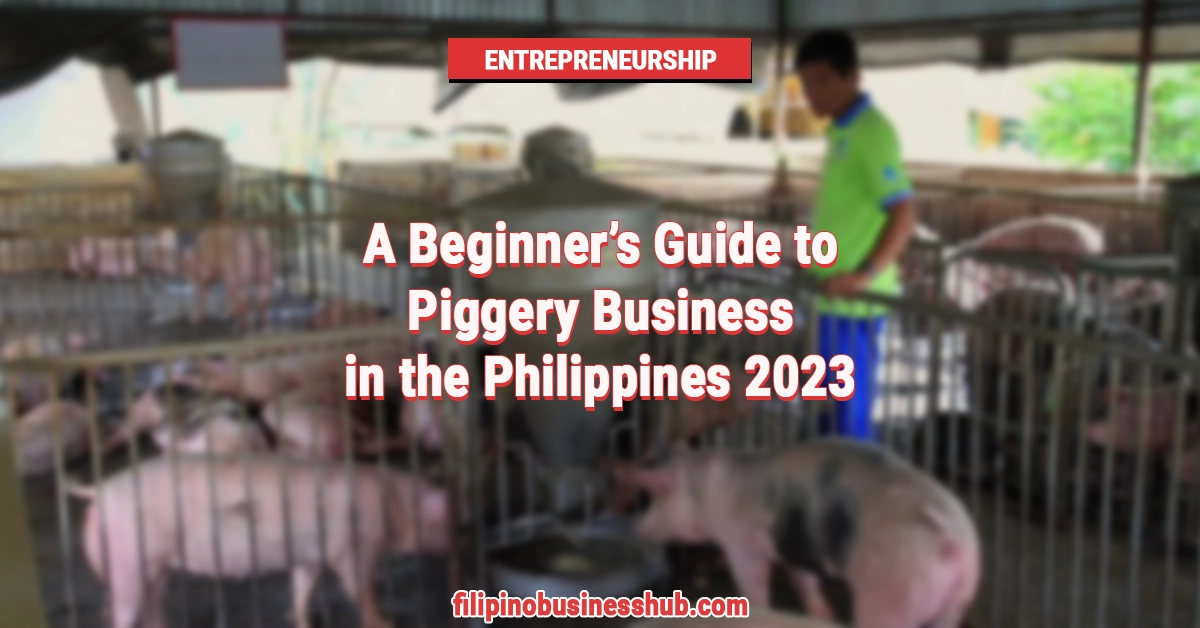
A Beginner’s Guide to Piggery Business in the Philippines 2023
The Philippines is known for its thriving agricultural industry, and one of the most profitable businesses in this sector is piggery farming. With a high demand for pork in the local and international markets, pig farming can be a lucrative venture for aspiring entrepreneurs. However, like any business, it also entails risks and challenges that must be carefully considered before venturing into it. In this article, we will discuss the various aspects of piggery farming in the Philippines, including its pros and cons, profitability factors, business risks, requirements and regulations, and tips for success. Whether you’re planning to start a small-scale backyard piggery or a large commercial operation, this guide will provide essential information to help you make informed decisions and succeed in this industry.
Table of Contents
What makes pig farming profitable.
Pig farming in the Philippines can be highly profitable due to a combination of factors. One advantage is its fast growth rate, meaning a quick return on investment (ROI). Furthermore, domestic consumption and export demand make pigs highly sought-after livestock in the country.
Pig farming offers many advantages, one being its ease of care. In addition, pigs are widely known to be cost-effective to feed as they can thrive on kitchen scraps, commercial feeds, or locally available ingredients; plus, their resistance to disease means lower veterinary expenses than other livestock.
Business Risks of a Piggery Business
As with any business venture, running a piggery in the Philippines carries its own set of risks. Here are some that you might face as a pig farmer:
- Market Risk: Demand for pork can fluctuate based on factors like seasonality, consumer tastes, and economic conditions; as a pig farmer, you face the risk of fluctuation in market prices that could eat into profits and negatively affect profits.
- Disease Outbreaks: Pigs can become vulnerable to infectious diseases that spread rapidly and kill entire herds quickly, resulting in significant financial losses for pig farmers.
- Feed Price Volatility: Feed costs can be an expense for pig farmers. Prices of ingredients used to create feed can fluctuate due to supply and demand issues, impacting profitability.
- Environmental Regulations: Pig farming can have a significant impact on the environment. As a pig farmer, you must abide by various environmental regulations, including waste disposal and management – any failure to abide by such rules can incur fines and penalties from regulatory bodies.
- Operational Risks: Pig farming poses numerous operational risks, including equipment breakdowns and power outages, which could impede operations and decrease profitability.
Pros and Cons Summary of a Piggery Business
- Fast Growth Rate = Fast ROI : One of the main advantages of pig farming is their rapid growth and maturation rate; therefore, farmers can anticipate seeing their return quickly with market weight achieved within months of starting farming operations.
- High demand : In the Philippines, pork is an indispensable food staple, and there is always an increased demand for it, creating a lucrative marketplace for pig farmers to sell their produce.
- Easy to raise : Pigs are relatively straightforward livestock to care for and require minimal space compared to cattle or goats. Furthermore, these adaptable creatures thrive under any environmental conditions, regardless of their surroundings.
- Cheap to Feed : Pigs are versatile omnivores and can be fed a range of food sources such as agricultural waste, kitchen scraps, and commercial pig feed. This makes them a cost-effective solution for farmers.
- Smelly and Noisy business: Pig farming can be an unpleasant business without effective waste management systems in place to handle manure disposal and noise generated by animals. Manure smell is strong and unpleasant, while animals may make noise that must be heard throughout a room or area.
- High Cost of Commercial Feeds : Although pigs can be fed from various food sources, commercially manufactured feed can be costly, adding production costs and decreasing profit margins for farmers.
- Vulnerability to Diseases : Although pigs tend to be healthy animals, they still become susceptible to certain diseases like swine fever and foot-and-mouth disease outbreaks that can have catastrophic results on farmers. Such outbreaks may result in significant losses.
- Inclement Weather : Typhoons or droughts can have a devastating impact on pig farming operations, affecting feed availability, water supply, and even animal health and wellbeing.
Problems Facing Pig Farming in the Philippines
Pig farming in the Philippines presents many unique obstacles which impede its profitability. Common issues faced by Filipino pig farmers include:
- Disease outbreaks : Pig farming is at risk from disease outbreaks that could pose significant financial losses for businesses in the Philippines, including African Swine Fever (ASF), Hog Cholera, and Foot-and-Mouth Disease. Farmers should implement biosecurity measures to safeguard against such outbreaks of infectious diseases.
- Fluctuating market prices : Pork prices in the market can fluctuate quickly, making it challenging for pig farmers to set competitive prices for their products. Supply and demand can have an immense impact on business profitability.
- High cost of inputs : Feed, labor, and other input costs may be high and harm your business’s production costs and profits. This may have detrimental repercussions on its profitability.
- Environmental regulations : Pig farming can produce large volumes of waste that harm the environment. Farmers must comply with environmental regulations and implement sustainable waste management practices to minimize this effect.
- Lack of access to financing : Accessing financing may present small-scale pig farmers with difficulty, as they may need more collateral to secure loans, invest in their businesses, and expand operations. This could hinder investment decisions as well as expansion plans.
- Lack of technical knowledge and training : Pig farming requires technical know-how and training to implement best practices and optimize production. With such knowledge, farmers may be able to manage their businesses effectively, leading to decreased productivity and profits.
The Importance of a Piggery Business Plan
A piggery business plan is a written document that details the objectives, strategies, and actions required to establish and run a successful pig farming enterprise. It serves as an essential resource to help determine whether their idea can be realized while simultaneously identifying challenges that may arise and developing solutions to overcome them.
An effective business plan is critical to any piggery business’s success. A properly written plan enables an entrepreneur to outline their purpose, goals, target market, and competitive analysis. A quality business plan also includes financial projections that project the income and expenses of their operation to help determine how much capital is necessary to start and operate it successfully.
An effective piggery business plan can also assist with obtaining funding from banks and investors, who often require detailed plans before agreeing to fund any venture. A comprehensive business plan increases your chances of receiving the adequate funds necessary to start and run the venture successfully.
Business plans provide entrepreneurs with a roadmap to reach their business objectives. A good business plan lets you stay focused and organized, taking all the steps needed to reach desired outcomes. Furthermore, they serve as an instrument to measure performance against stated objectives, helping the entrepreneur make informed decisions and changes where necessary.
Overall, a piggery business plan is an indispensable resource for entrepreneurs seeking to launch and run a profitable pig farming operation in the Philippines. It provides a roadmap toward meeting desired outcomes by outlining a framework and helping secure financing.
Types of Piggery Business
Before beginning a piggery business in the Philippines, it’s essential to determine its type. Two main categories of piggeries include breed and grow and grow-out operations.
Breed and Grow vs. Grow-Out
Breed and grow refers to a piggery business that involves breeding and raising piglets until they reach maturity, typically over an extended timeframe and higher initial investment, but offers higher returns in return.
Grow-out piggery businesses involve purchasing young piglets and raising them until market weight. While this requires less investment and time commitment, its returns are typically smaller.
Independent Grower vs. Contract Grower
As well as considering which type of grower operation best suits them, another factor to consider is whether they want to operate as an independent or contract grower. Independent growers own and manage their pig production, while contract growers provide service for companies or corporations.
Ultimately, deciding upon a piggery business type depends on your resources, goals, and preferences as an entrepreneur.
Determining Your Business Setup
Acquiring starter pigs or adopting a grow-out system.
When starting a piggery business in the Philippines, determining the proper business setup is crucial for success. One important decision is whether to acquire starter pigs or adopt a grow-out system.
Acquiring starter pigs involves purchasing young pigs from breeders or other sources and raising them until they reach the desired weight or age for selling. This approach requires more resources and attention to ensure the healthy growth of the pigs.
On the other hand, adopting a grow-out system involves taking in young pigs for a fee and raising them to the desired weight or age as contracted by a third-party entity. This approach requires less capital and management skills as the third-party entity provides the piglets and oversees their growth, but it also means a lower profit margin.
When deciding on the business setup, it’s essential to consider factors such as the available resources, level of experience, and market demand.
Business Requirements for a Piggery Business in the Philippines
Several requirements must be fulfilled to operate a piggery business in the Philippines legally. Below are the six primary requirements:
1. Register Your Piggery Business
Before opening any business in the Philippines, its details must be registered with either the Department of Trade and Industry (DTI) or the Securities and Exchange Commission (SEC), depending on its nature. Doing this ensures your piggery is legally recognized within its operating boundaries.
2. Obtain Barangay Clearance
To conduct business within the local barangay’s jurisdiction, obtaining a barangay clearance certification from its hall is necessary.
3. Acquire a Mayor’s Business Permit and Sanitary Permit
These permits can be obtained from Municipal or City Hall and validate that your business can operate legally within its area, while the Sanitary Permit ensures public health safety is maintained at your piggery.
4. Register with the Bureau of Internal Revenue (BIR)
All businesses operating in the Philippines are required to register with the Bureau of Internal Revenue and obtain a Tax Identification Number (TIN) to ensure they pay all applicable taxes according to regulations and comply with tax compliance obligations. This ensures your piggery business meets tax regulations correctly.
5. Register with the SSS, PhilHealth, and Pag-Ibig Fund
These government agencies offer benefits such as social security, health insurance, and loan programs for employees of your piggery business. You must register with these agencies to hire employees.
6. Secure an Environmental Certificate
Obtain an Environmental Certificate: This certification from the Department of Environment and Natural Resources (DENR) ensures that your piggery does not harm the environment, which is particularly important given that piggery businesses often generate large volumes of waste and pollutants that must be managed appropriately to function efficiently.
Location Requirements of a Piggery Business
- Choose a location away from residential areas and water sources to avoid contamination and odor issues
- The location must be accessible for the transport of pigs and supplies
- The site must have good drainage and be flood-free
- The soil must be suitable for construction and able to support the weight of the pig houses and equipment
- Adequate space must be available for the construction of pig houses, feed storage, and other necessary facilities
- The site must have a reliable source of water and electricity
- The location must be compliant with zoning and environmental regulations
Pig Housing Requirements in the Philippines
Philippine pig houses must meet certain specifications to ensure the comfort and health of its residents, with some essential requirements including:
- Ventilation: To keep ammonia levels under control and to regulate temperature and humidity levels inside the pig house, proper ventilation must be installed in its interior space. Achieving good ventilation also provides for more uniform temperature distribution in its environs.
- Flooring: To prevent slipperiness and moisture build-up, flooring must be nonslip and easy to keep clean. Furthermore, good drainage should be available to reduce waste accumulation.
- Lighting: Lighting is vitally important for maintaining the health and productivity of pigs. An optimal environment requires both natural and artificial illumination that regulates biorhythms while stimulating growth.
- Watering System: To provide its pigs with fresh, clean water at all times, the pig house must contain an efficient watering system that is easy to use and clean up after. Furthermore, maintenance should be minimal with this type of setup.
- Feeding System: To ensure optimal conditions in their pig house, owners should install an efficient feeding system that allows for the easy distribution of feed to their animals while remaining easy to clean and maintain.
- Space: To provide comfort for the pigs in a home environment, there must be sufficient room. This depends on their size and age.
- Biosecurity: To avoid disease transmission in pig houses, proper biosecurity measures must be implemented, such as quarantine areas, footbaths, and disinfection protocols.
As specific requirements can vary depending on the location and size of your pig house, it is wise to consult a veterinarian or expert in pig farming to ensure that the house meets all necessary standards.
Choosing the Right Piglets
Common pig breeds in the philippines.
There are several pig breeds that are commonly raised in the Philippines for meat production. Here are a few popular breeds:
Yorkshire or Large White
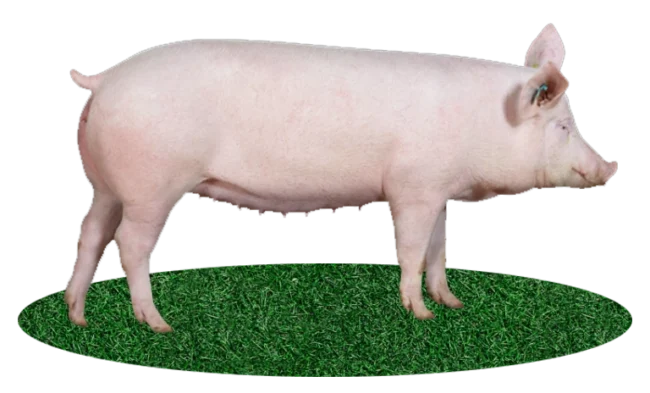
This breed is well known for its high lean meat content, fast growth rate, adaptability to various environmental conditions, and immunity to common pig diseases.

These breeds are known for their large, drooping ears and high meat yield, along with excellent mothering abilities that make them popular choices when breeding sows.
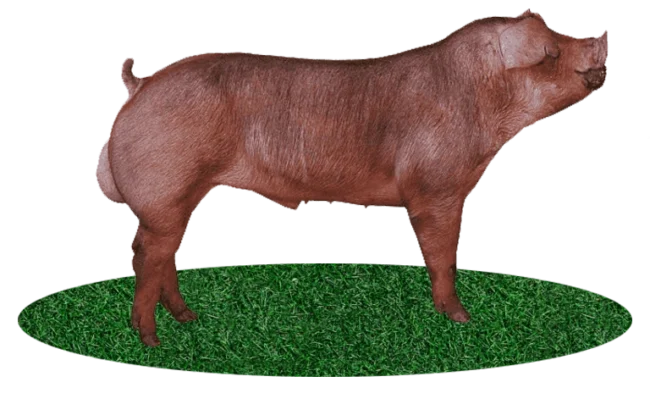
Duroc breed is well known for its flavorful meat, high growth rate, and efficient feed conversion efficiency, making them an economical option for commercial farming operations.
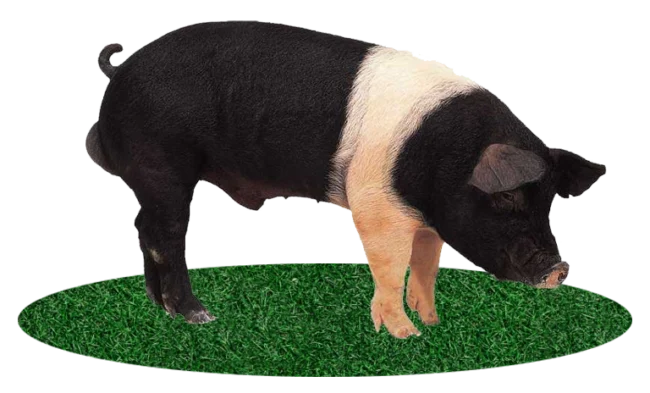
This breed is well known for its muscular bodies and excellent meat quality, along with being resistant to stress – making them an excellent choice for intensive farming systems.
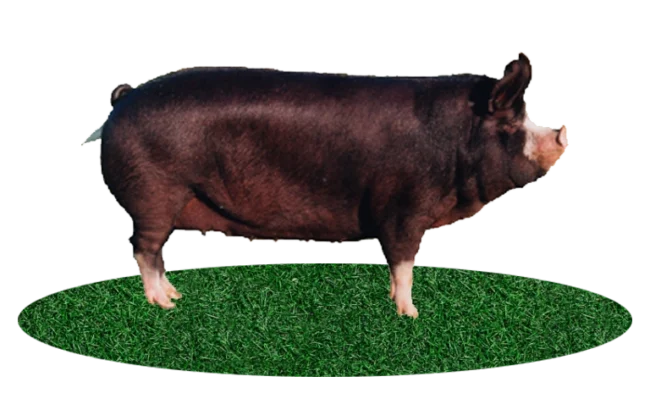
This breed is prized in the culinary industry due to its marbled meat. Furthermore, they boast good mothering abilities and adapt well to various feeding systems.
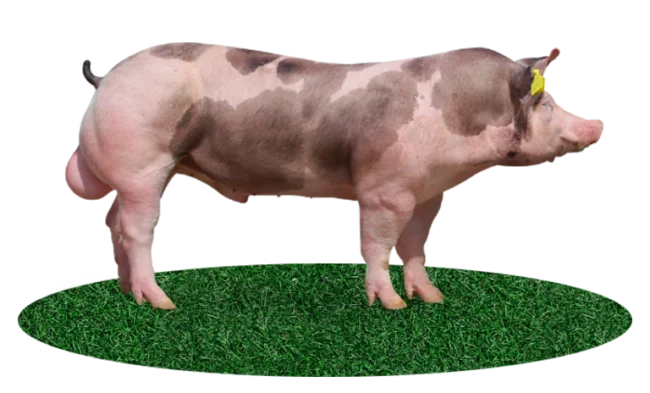
This breed is well known for its high lean meat content and rapid growth rate, and its resistance to stress makes them ideal for intensive farming systems.
Other Breeds to consider:
Philippine native pig (pnp).
Also referred to as an “asal” or a “native baboy”, these traditional breeds have been raised throughout the Philippines for centuries. They are known for their hardiness, adaptability to local conditions, and flavorful meat.
This breed is recognized for its long snout and ginger-colored fur. They excel at foraging for food outdoors, making them an excellent option for free-range farming systems.
Meishan breed is distinguished by their wrinkled faces and large, floppy ears, as well as their high reproductive performance and large litter sizes, making them an excellent choice for sow breeding programs.
Hampshire-Duroc crossbreeds
This hybrid breed is widely popular in the Philippines, as it combines the meat quality of Hampshires with the growth rate of Durocs for optimal commercial pig farming resulting in high meat quality and growth rates in each piglet. This results in high meat yield and rapid development rates that make this hybrid ideal.
Pietrain-Duroc crossbreed
This crossbreed combines the fast growth rate and lean meat content of Pietrain with the high feed efficiency and reliable growth rate of Duroc for maximum lean meat content and rapid growth rate, making this cross an excellent choice for intensive farming systems.
Selecting an ideal pig breed for your piggery business depends on several considerations, such as its target market, farming system, and production goals. Do your research and consult experts to decide which breed will work best in terms of production efficiency and market trends.
Important Piggery Farming Tips
Start small.
Starting with a manageable number of pigs is essential, especially if you are new to the industry. This will allow you to gain experience and knowledge on properly caring for and managing the pigs before expanding your business. Starting small also means minimizing your initial investment and reducing your risk of financial loss.
Obtain Financial Aid
Starting a piggery business can be expensive, so exploring financial aid options such as loans or grants is essential. This can help cover the cost of acquiring starter pigs, constructing pig houses, and purchasing equipment and feeds. Be sure to research and compare different options to find the best fit for your business needs.
Get Technical Help
It is always a good idea to seek technical assistance and advice from experts in the field, especially if you are new to the industry. This can help you avoid common mistakes and learn best practices for pig farming. You can seek assistance from government agencies, universities, or private organizations specializing in pig farming. Attend seminars, workshops, or conferences to gain new knowledge and skills to improve your operations.
Easy Step Guide to Piggery Farming
Establishing a piggery farming business can be both rewarding and profitable; however, it also requires hard work. A solid plan must be put in place, along with being aware of any challenges that might arise along the way. By following these eight easy steps and staying current with industry developments and best practices, you’ll soon be well on your way to running a profitable piggery farming enterprise! Good luck on your journey!
Step 1: Receive Training to Raise Pigs
Before starting your own piggery farm, it is crucial to equip yourself with knowledge and skills on caring for pigs properly. This knowledge can be gained by attending seminars, workshops, or training programs.
Step 2: Select an Appropriate Land
When it comes to piggery farms, choosing an ideal location is paramount. In addition, your piggery farm needs adequate drainage and ventilation systems, proximity to residential areas that do not interfere, clean water supplies available nearby, and access to electricity if applicable.
Step 3: Obtain Productive Pig Breeds
You must select productive pig breeds that can thrive in your location and meet market demands, considering factors like growth rate, feed conversion efficiency, and disease resistance when making this selection.
Step 4: Start the Pig Housing Process
Establishing proper housing for your pigs is vital to their health and comfort, so ensure it is clean, well-ventilated, and offers enough room for movement.
Step 5: Feed the Pigs Efficiently
Providing your pigs with appropriate feed and nutrition is vital to their growth and well-being, so consult animal nutrition specialists to create a balanced diet.
Step 6: Initiate the Breeding Process
Beginning breeding procedures is crucial in keeping an adequate supply of piglets for sale or raising. Ensure your breeding stock is healthy, and develop an action plan.
Step 7: Ensure Proper Care and Management
Providing your pigs with proper care and management practices is paramount to their health and productivity, including regular health check-ups, waste disposal strategies, and disease prevention measures.
Step 8: Focus on Marketing Your Products
To successfully promote and market your products, you must identify target buyers and develop marketing strategies accordingly. For example, consider joining farmers’ markets or creating direct relationships with restaurants and meat shops to promote your pig products.
Feeding Management of Pigs
Feed management is a critical element of pig farming to ensure their health and productivity. As omnivores, their diet must provide them with enough essential nutrients for healthy development and growth. Here are a few critical considerations for effective feeding management in pig farming:
- Feed Composition: Pig feed should contain a balanced combination of proteins, carbohydrates, fats, vitamins, and minerals for proper growth, reproduction, and disease prevention.
- Feeding Schedule: Pigs should be fed twice daily to ensure sufficient nourishment. Their feeding schedule should remain regular to avoid digestive issues and promote optimal weight gain.
- Feed Quantity: Feed amounts should vary based on each pig’s weight, age, and stage of development. Overfeeding may lead to obesity, while underfeeding can hinder their growth and productivity.
- Feed Quality: For optimal pig health, feed should be free from contaminants such as mold and pesticides to avoid potential health problems in their digestive systems.
- Water: Pigs need access to fresh, clean water at all times for digestion, hydration, and maintaining body temperature regulation. Adequate intake ensures effective digestion, hydration, and regulation.
- Feeder and Waterer Design : When designing feeders and waterers for pigs, their design must consider their size and age, as well as provide durable equipment that’s easy to use and clean – and prevent unnecessary waste.
- Feed Storage: For optimal results, feed should be kept in a dry, calm, and ventilated location to reduce spoilage and contamination.
- Feed Costs: Feed costs can be an expensive component of pig farming, and farmers should aim to minimize waste and optimize the conversion ratio to decrease overall costs.
Feed management is critical to the success of pig farming operations. Routine monitoring of feed intake, body condition scores, and growth performance can help identify health or nutrition issues early on.
Health Management for Pig Farming
Health management is an essential aspect of pig farming to ensure the health and productivity of the pigs. Here are some critical practices for effective health management in pig farming:
- Vaccination : Vaccination is essential for preventing and controlling diseases in pigs. It is important to follow a vaccination schedule recommended by a veterinarian to ensure that pigs are adequately protected against common diseases.
- Biosecurity measures : Biosecurity measures are put in place to prevent the introduction and spread of diseases on the pig farm. These measures may include quarantining new animals, limiting visitors, providing proper sanitation, and using protective gear.
- Parasite control : Parasites can have a significant impact on the health and productivity of pigs. Proper deworming and treatment for external parasites should be implemented regularly to ensure optimal health.
- Proper nutrition : Providing proper nutrition is essential to maintain the health and productivity of pigs. A balanced diet that meets the nutritional requirements of pigs at each stage of growth should be provided.
- Observation and monitoring : Regular observation and monitoring of the pigs can help to identify any health problems early. Early detection can lead to prompt treatment, minimizing the impact of disease on the pig herd.
- Record keeping : Accurate records of pig health, medication, vaccination history, and production data are essential for effective health management. This information can help identify trends and potential problems and inform decision-making for the management of the pig herd.
By implementing these health management practices, pig farmers can help ensure the health and productivity of their pigs while minimizing the risk of disease outbreaks on the farm.
Final Thoughts
Pig farming in the Philippines can be a rewarding and successful venture but requires meticulous planning, research, and management to succeed. As with any business endeavor, challenges will always be associated with it; however, with the appropriate knowledge and preparation, these can be overcome successfully.
Starting a piggery business involves numerous considerations, from obtaining permits and registrations to choosing suitable land and breeds for breeding pigs to building housing with appropriate feeding management systems to ensure their health and welfare, among others.
First, educating yourself about the industry is vital, as seeking advice from experienced pig farmers and keeping up-to-date with the latest farming techniques and trends. You can build a prosperous and lasting business venture by adhering to this guide’s steps and following best practices for pig farming.
Piggery in the Philippines can provide an income source and contribute to its flourishing agricultural sector with hard work, dedication, and high-quality pork products.
Frequently Asked Questions
Is pig farming profitable in the philippines.
Yes, pig farming can be a profitable business in the Philippines due to the high demand for pork meat in the market.
How can I raise my pig faster?
You can raise your pig faster by providing them with proper nutrition, suitable housing, and hygiene management, as well as by maintaining a regular vaccination and deworming schedule.
What common diseases affect pigs, and how can they be prevented?
Common diseases that affect pigs include swine fever, foot-and-mouth disease, and porcine reproductive and respiratory syndrome (PRRS). These diseases can be prevented through proper vaccination, quarantine, and hygiene management practices.
How do I market my pig products?
You can market your pig products through various channels such as social media, direct selling, and through local markets and meat shops.
What are the financing options available for starting a piggery business?
There are various financing options available for starting a piggery business in the Philippines, including bank loans, government-sponsored programs, and private investors.
How much land is required for a piggery business?
The amount of land required for a piggery business depends on the size of the operation. For a small-scale piggery, around 100 to 1000 square meters of land may be sufficient.
What are the legal requirements for transporting pigs?
Legal requirements for transporting pigs include obtaining the necessary permits and licenses, ensuring proper documentation and identification, and complying with biosecurity measures.
What are the best practices for animal welfare in piggery farming?
Best practices for animal welfare in piggery farming include providing adequate space and housing, proper nutrition and feeding management, regular veterinary care, and humane handling and transportation.
How do I manage waste and manure from my piggery?
You can manage waste and manure from your piggery by using proper disposal methods, such as composting, and ensuring that manure does not contaminate nearby water sources.
What is the typical lifespan of pigs in a piggery business?
The typical lifespan of pigs in a piggery business can vary depending on the purpose of the operation. Breeding sows can live up to 5-6 years, while pigs raised for meat can be slaughtered as early as 4-6 months of age.
Can I combine pig farming with other agricultural activities, such as crop farming or poultry farming?
Yes, pig farming can be combined with other agricultural activities, such as crop farming or poultry farming, to maximize land use and profitability.
How can I improve the genetics of my pig herd?
You can improve the genetics of your pig herd by selectively breeding high-performing pigs and culling those with poor traits, as well as by introducing new genetics through purchasing new breeding stock.
Similar Posts

Limang Dapat Tandaan sa Pagtatayo ng Maliit na Negosyo

Sabon ni Kabayan: From Failures to Soapy Success – Resilience, Innovation, and Empowerment!

The Top 10 Successful Entrepreneurs in the Philippines 2023

Where to Find 2nd Hand Vending Machines in the Philippines

10 Common Business Issues in the Philippines

20 Filipino Trademarks That Captivate Hearts and Minds
Leave a reply cancel reply.
Your email address will not be published. Required fields are marked *
Save my name, email, and website in this browser for the next time I comment.

IMAGES
VIDEO
COMMENTS
Piggery business is one of the traditional businesses of Filipinos. The industry ranges from backyard ventures to commercial scale. This business has thrived because of one thing: Filipinos love to eat pork. Here, we will guide you on how to start your piggery business.
A complete guide on how to start a piggery business in the Philippines. Learn the business risks, determining your business setup, business requirements, etc.
A step by step guide on how to start pig farming in the Philippines, pig breeds, cost to start pig farm in the Philippines. Advantages of pig farming in the Philippines. Different pig breeds in the Philippines. Location requirements and recommended layout for Piggeries.
Starting a Profitable Piggery Business in the Philippines: A Step-by-Step Plan for Choosing Pig Breeds, Establishing a Farm, and Estimating Startup Costs.
In this comprehensive guide, we’ll walk you through everything you need to know to start your own successful piggery business in the Philippines. From acquiring starter pigs to obtaining necessary permits and registrations, we’ve got you covered every step of the way.
How to Start a Piggery Business in the Philippines. Hog raising has been one of the profitable agricultural enterprises for Filipinos. In fact, this venture is commonly practiced by average Filipinos as they earn a reliable income. With the pretty return of investment, more and more individuals are caught up to start a piggery business.